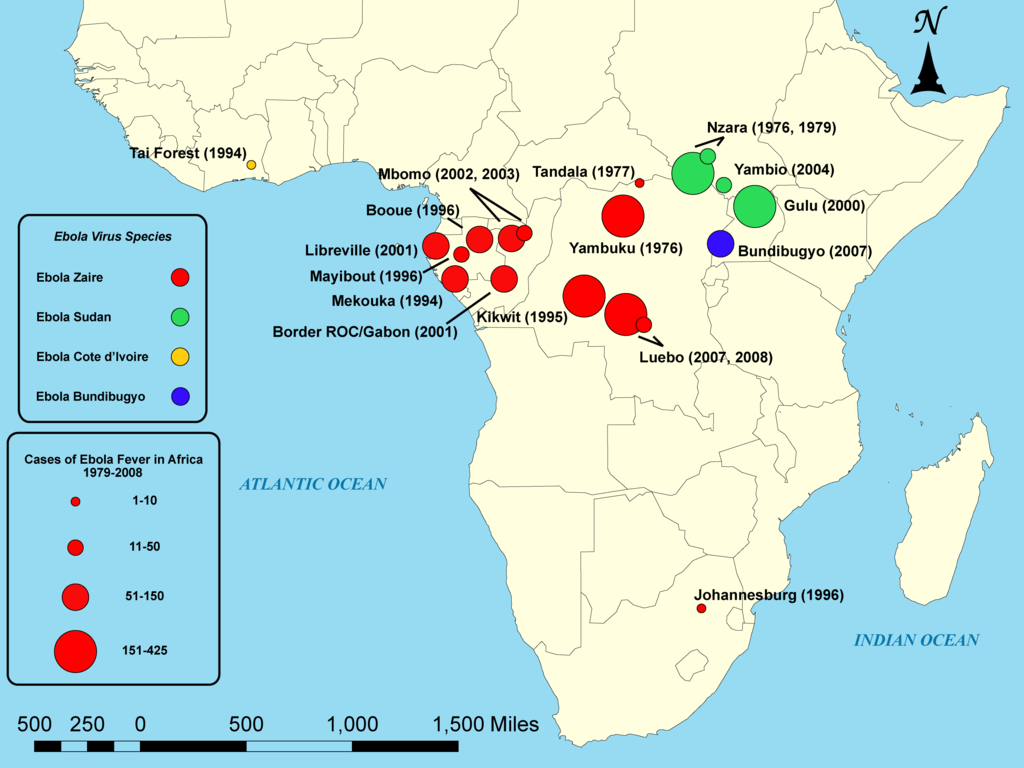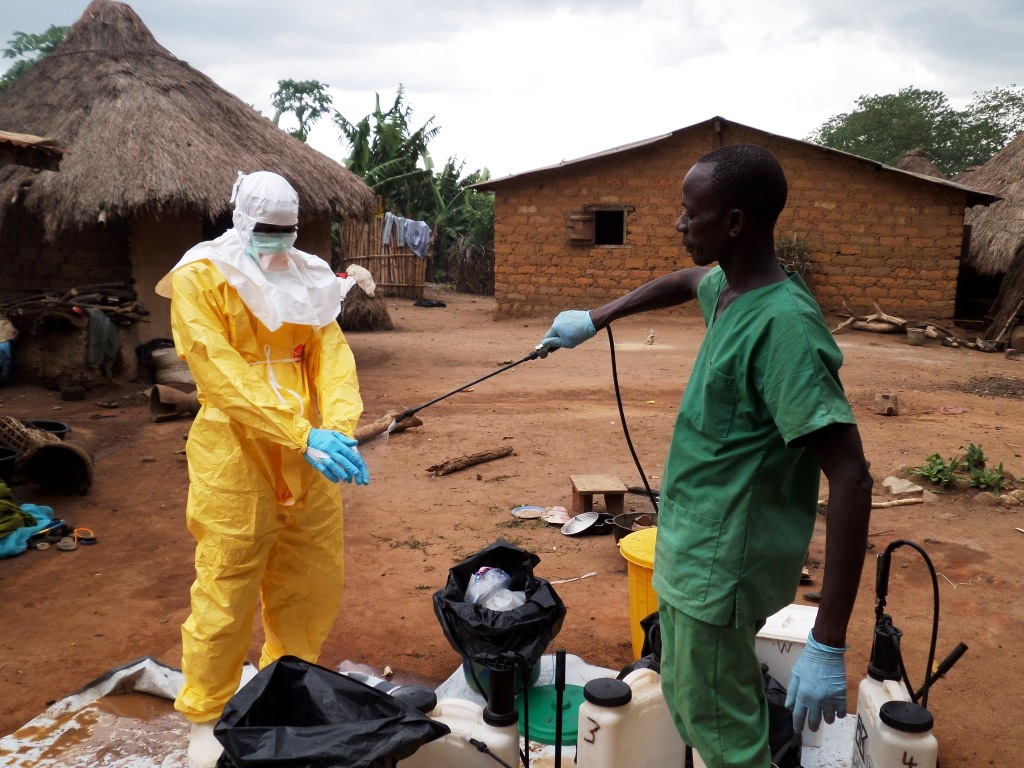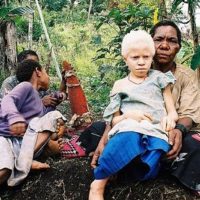The importance of Artificial Intelligence (AI) continues to grow with the enhanced integration of all kinds of technologies into a daily human routine, as can be seen especially from a robust body of research on easing the aspects of work and social life. The health care sector has undeniable importance in ensuring society’s wellbeing and therefore, the research on AI’s use in it should not be overlooked. In fact, the use of AI in the health sector might constitute a significant improvement in terms of further research, development of new instruments, and prognosis of the spread of diseases. The presented text shows how invaluable AI in the health sector is by presenting the case of Ebola, one of the most serious health crises in the recent past, and argues for continuous and increased use and wider acceptance of AI.
Assessing the Ebola Virus
The Ebola virus epidemic prevails the most in West Africa, although it first appeared in South Sudan and the Democratic Republic of the Congo (DRC) in 1976. [1][2] It has surfaced periodically since then and took many lives – for instance, during the 2014-2016 occurrence 11,323 people were left dead, out of 28,646 confirmed cases, as recorded by the Centers for Disease Control (CDC) and World Health Organization (WHO). [3] The natural reservoir of the virus remains unknown, but fruit bats are considered the most likely reservoir host. [2][4] The case fatality rate of the disease ranges from 41 % to 90 %, depending on the strain. [5] There are five known strains; Zaire Ebola virus, Sudan Ebola virus, Tai Forest Ebola virus, Bundibugyo Ebola virus, and Reston Ebola virus. [3][5] The Zaire Ebola Virus is “identified as the deadliest of the five strains,” and in fact, the name Ebola “was derived from the Ebola River located near the source of the first outbreak”. [5] The disease has also been recorded in some other countries besides the ones mentioned above, such as Uganda, Sierra Leone, Guinea, Liberia, Gabon, and the Republic of Congo, as well as in some European countries, like the United Kingdom, Italy and Spain, and the United States. Due to the global spread, the WHO proclaimed Ebola a world healthcare crisis. [6]
The Ebola virus is transmitted by direct contact or up to 3 feet away from an infected person. The means of transmission include blood, secretions, digesting or touching organs like the liver, spleen, and kidney, or bodily fluids like breast milk, semen, sweat, and urine of infected animals and of infected people, whether dead or living. [2][4] Even objects touched by an infected person might become a means of transmission of the disease. [4] However, one becomes infectious only after experiencing the first symptoms, which can appear within 2-21 days after an infectious contact. The symptoms may include fever, severe headaches, muscle, joint and abdominal pain, fatigue, sore throat, loss of appetite, vomiting, etc. [2][7] The similarity of Ebola symptoms to those of other illnesses like flu, malaria, typhoid or even Covid-19, in combination with quite a long period of incubation only makes the indication harder. With the application of AI, early indication, amongst other issues that will be discussed, can be addressed.

Use of AI in the Case of Ebola
AI in health care is based on computing available data and health information which results in the possibility to predict potentially threatening health issues. With the application of medical informatics – “the science behind how to use data, information, and knowledge to improve human health and the delivery of health care services” [8] – into healthcare, as well as into AI, it has become possible for medical organizations to introduce mobile applications for the use of the wider population.
One of such applications is the Ebola Exposure Calculator which can estimate when a person was exposed to the virus. The use of these applications would “guide clinical decisions by organizing existing knowledge of patient care and management more efficiently and making it easily available”. [9] The higher the level of data accessible to AI, the more accurate it can get as this allows the machine learning mechanism to absorb more information and patterns. [10]
Embedding AI into Ebola prediction and treatment should not be a problem given the fact that the healthcare sector owns a massive amount of data through the medical history of patients. In order to achieve personalized healthcare through patient-specific information, wearables and smartwatches like the Apple Watch and Fitbit as well as smartphones can be of immense usefulness. These devices already have inbuilt applications that can track the health of individuals. With the symptoms of Ebola already known, information gathered through these devices can be imported into the Ebola Exposure Calculator to determine if the individual(s) has been exposed to the disease. Of course, an agreement will have to be reached with the companies that produce such devices but with these, prediction of the virus can be accomplished for individuals rather than communities. [5]
Deployment of these types of applications is invaluable, especially in low-resourced and difficult-to-access locations in countries most affected by Ebola outbreaks. For these locations, and the rest of the world, this can be beneficial in improving clinical health data management, processing large data sets for diagnosis, improving health care in low-resource areas, and speeding up drug development. [11] The use of these devices can then help with the continuous gathering of medical data for medical experts’ use in improving preventive measures and diagnoses. It can also be used for AI in order to improve the designing and training of software algorithms to learn from and act on the data. [12]
Smart Technologies and International Cooperation
The latest Ebola outbreak in 2018-2020 recorded a significantly smaller number of cases than the previous one in 2014-2016. Still, it is the second biggest Ebola outbreak since its first occurrence in 1976 [3], meaning there is still a lot to be done to achieve total eradication. The possibility to track individuals and predict if they have been infected through AI-enabled devices poses to be the final piece of the puzzle. Nevertheless, this also raises questions and concerns about ethics, patient information protection, and the challenges associated with poor states and incapable governments.
We live in a digital world, smartphones and other electronic devices, and underdeveloped countries are no exception. Almost everyone should be able to operate these kinds of applications. In the rare cases where this is not so, the local public clinics can be funded to have the devices made publicly accessible to the population that must be fully informed of the possibility of being trained on how to use them. The presence of the United Nations individual bodies or permanent representation might constitute a huge help in setting the individual strategies and implementing the needed means on national levels.
Collaborative efforts between international organizations (like Google and Apple that will help with the devices and applications), nongovernmental organizations, and the governments of states directly affected (DRC, Uganda, and the likes) will be needed. Incorporating AI technology into any sector requires significant funding, and bringing in international organizations can be a means of sharing the financial burden. Nongovernmental organizations (NGOs) could help with providing the support needed for these underdeveloped and developing countries to make proper policies and reach all communities. Also, they would be useful in making these devices (relatively) accessible so they could be provided to everyone, especially financially challenged individuals. This is hardly possible for the governments of these states to achieve on their own because of scarce funds and the constant need to direct the little available to more pressing issues. That said, all stakeholders should show clear will and openness for this to be effective. Hidden propaganda and agendas should not be brought into the health security.
This collaboration will bring about a two-edged challenge. The public communication of the worldwide effort, under the umbrella of the United Nations and other international organizations (IOs), is important since it should contribute to some level of credibility and trust in the proposed solutions. This is given, amongst others, by the lack of trust in national governments by (some of) the citizens, often occurring in less developed countries. However, this is not exclusive; there are also people that do not trust any representation of foreign help because of the colonial history. Those that will see this as a type of neocolonialism will be sharpening their proverbial swords to strike down any efforts that look remotely similar to colonization. To address this, local organizations with expertise in the field of AI should also be involved in the process and complete transparency should be the basis of every and any development.
Personalized Health Care and Privacy Concerns
Personalized health care can be made possible through the distribution and use of smart devices. Thanks to them and the AI, it would be possible for individuals to be notified after their exposure to the virus. They can then go into isolation and help ensure that the risk of spreading the disease unconsciously is avoided. Epidemics turn into pandemics quite easily, therefore, it is in the interest of many parties to trace and contain such highly infectious diseases. Sharing of AI expertise and know-how, and its enhanced application in the health sector should contribute significantly to such efforts. AI allows not only to ameliorate the early detection of cases and conduct certain projections, but it could also help to develop more personalized attitudes in the subsequent care and medication.

This virtual health assistance will take a huge workload off the shoulders of medical practitioners and on-ground workers. Their efficiency might be improved by being able to pinpoint the location of the infected because of the possibility to track the devices. It will also help reduce the risk of the medical workers being infected while trying to perform their duties because they would be able to identify potentially infectious patients. The turnout of this would be a huge reduction in the number of infected, and eradicating the disease then becomes more feasible.
Of course, there are also ethical concerns associated with this proposal, especially for those that will be using the devices outside the walls of medical facilities, which should be basically everyone. It would mean an increased possibility of surveillance and tracking of individuals in their communities, beyond the surveillance for medical purposes. Health information would not be as private as one could hope for, given the collaboration with IOs and the fact that there will be non-medical practitioners with access to the information in order to improve the intelligence of the devices. It is understandable that many people will find this a clear breach of medical privacy. Besides that, one must recognize the external threats as well – the possibility of being hacked “since individuals from different departments might require access to electronic health records, they are mostly web-based making them vulnerable to these attacks”. [13]
Possible Outcomes and Future of AI in the Health Care
However, the end might justify the means here and there are non-disclosure agreements that can be signed. Full ethical responsibilities will also need to be taken by IOs and their staff to ensure the protection of the information they will become privy to. The international community – UN, WHO, and the likes – will also need to closely monitor them and hold them fully accountable. These concerns can and should be addressed by the health information privacy acts hence the need to review the act as is to ensure there are no loopholes and that patients remain protected, and people are assured of their privacy.
AI and medical care for infectious diseases are broad and separate topics and this text barely addresses the possibilities, issues, and challenges. However, it gives an insight into what can be possible by their merge. We continue to learn the full grasp and use of AI and one thing is certain – infectious diseases might not have been always preventable but with recent technologies, they are certainly more controllable in their early stages. Collaboration of personalized health care through the use of AI, and smart devices with already established medical practices can go a long way in controlling, preventing, and proffering solutions to Ebola, a disease that has plagued a region for decades, as well as other deadly diseases.
References
[1] Buseh, A. G. (2020, October 1). The Ebola epidemic in West Africa: Challenges, opportunities, and policy priority areas. NCBI. Retrieved July 11, 2022, from https://www.ncbi.nlm.nih.gov/pmc/articles/PMC7111626/
[2] WHO. (2021, February 23). Ebola virus disease. WHO | World Health Organization. Retrieved July 13, 2022, from https://www.who.int/news-room/fact-sheets/detail/ebola-virus-disease
[3] CDC. (n.d.). Ebola Virus Disease Distribution Map: Cases of Ebola Virus Disease in Africa Since 1976 | History | Ebola (Ebola Virus Disease). CDC. Retrieved July 11, 2022, from https://www.cdc.gov/vhf/ebola/history/distribution-map.html
[4] CDC. (n.d.). Transmission | Ebola Hemorrhagic Fever. CDC. Retrieved July 13, 2022, from https://www.cdc.gov/vhf/ebola/transmission/index.html
[5] Jain, A. (2017, August). PREDICTIVE MODELS FOR EBOLA USING MACHINE LEARNING ALGORITHM by Abhishek Jain. A Thesis Submitted to the Faculty of The College o. Retrieved July 13, 2022, from http://fau.digital.flvc.org/islandora/object/fau%3A38026/datastream/OBJ/view/Predictive_Models_for_Ebola_using_Machine_Learning_Algorithms.pdf
[6] Soni, U., Gupta, N., & Sakshi. (2021). An Artificial Intelligence Approach for Forecasting Ebola Disease. Journal of Physics: Conference Series, 1950(012038), 10. Journal of Physics. 10.1088/1742-6596/1950/1/012038
[7] CDC. (n.d.). Signs and Symptoms | Ebola Hemorrhagic Fever. CDC. Retrieved July 13, 2022, from https://www.cdc.gov/vhf/ebola/symptoms/index.html
[8] Hu, J. (2020, November 16). Driving the usefulness of AI in healthcare: IBM Research showcases work at AMIA 2020. IBM. Retrieved July 13, 2022, from https://www.ibm.com/blogs/research/2020/11/ai-healthcare-amia-2020/
[9] Colubri, A., Hartley, M.-A., Siakor, M., Wolfman, V., Felix, A., Sesay, T., Shaffer, J. G., Garry, R. F., Grant, D. S., Levine, A. C., & Sabeti, P. C. (2019, June 22). Machine-learning Prognostic Models from the 2014–16 Ebola Outbreak: Dataharmonization Challenges, Validation Strategies, and mHealth Applications. EClinicalMedicine. Retrieved July 13, 2022, from https://www.thelancet.com/action/showPdf?pii=S2589-5370%2819%2930096-3
[10] ResolveData. (2021, December 16). Can AI help overcome data security challenges and patient trust for the healthcare industry? LinkedIn. Retrieved August 5, 2022, from https://www.linkedin.com/pulse/can-ai-help-overcome-data-security-challenges-patient-trust-/?trk=organization-update-content_share-article
[11] Dhilawala, A. (n.d.). 21 Jan Benefits of Artificial Intelligence in Healthcare & Medicine. Galen Data. Retrieved July 13, 2022, from https://www.galendata.com/ai-benefits-healthcare/
[12] US FDA. (2021, September 22). Artificial Intelligence and Machine Learning in Software as a Medical Device | FDA. US Food and Drug Administration. Retrieved July 13, 2022, from https://www.fda.gov/medical-devices/software-medical-device-samd/artificial-intelligence-and-machine-learning-software-medical-device
[13] V-Soft Consulting. (n.d.). The Importance of Data Security in AI-Enabled Healthcare. Blog. Retrieved August 5, 2022, from https://blog.vsoftconsulting.com/blog/the-importance-of-data-security-in-ai-enabled-healthcare





